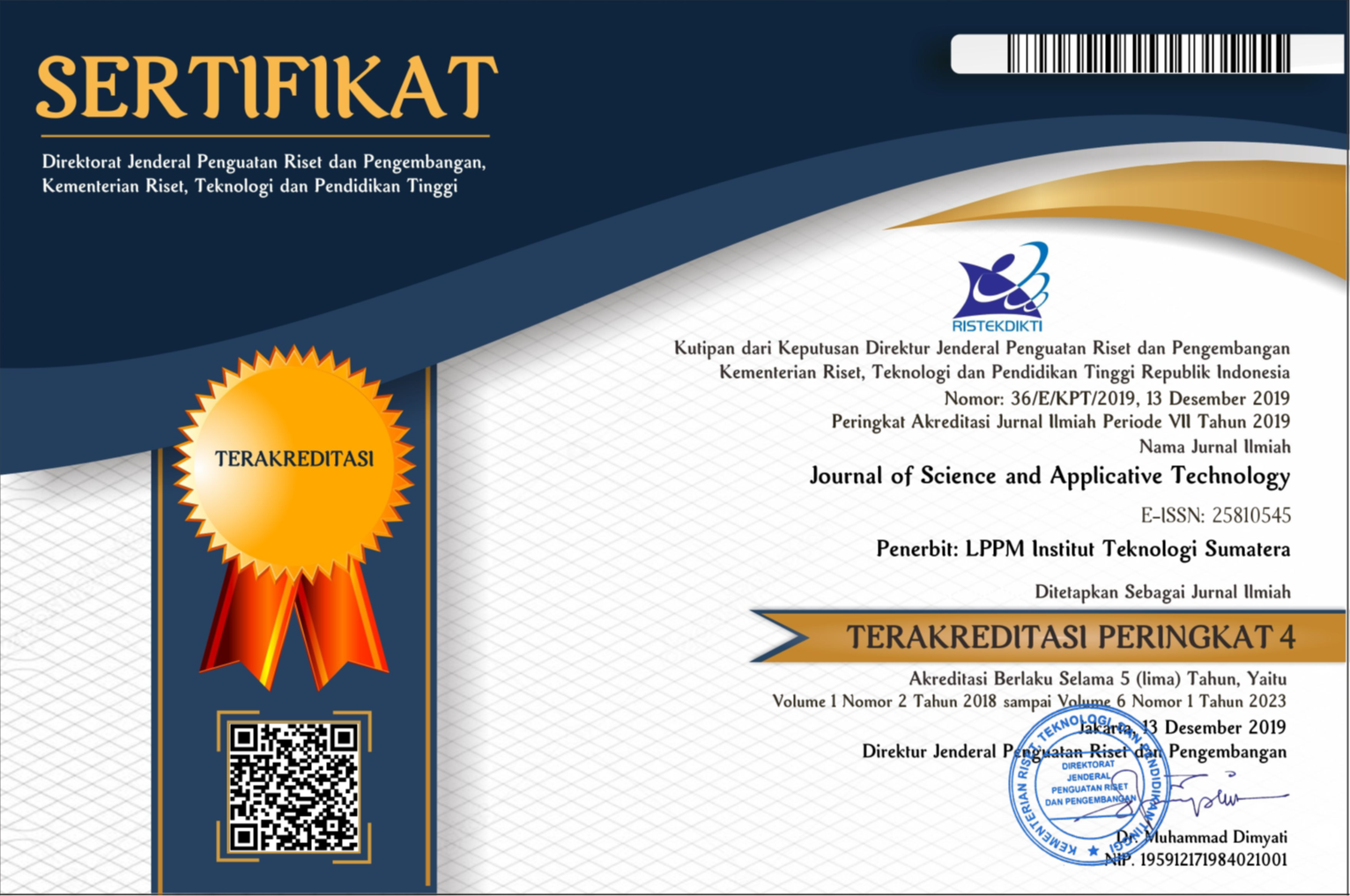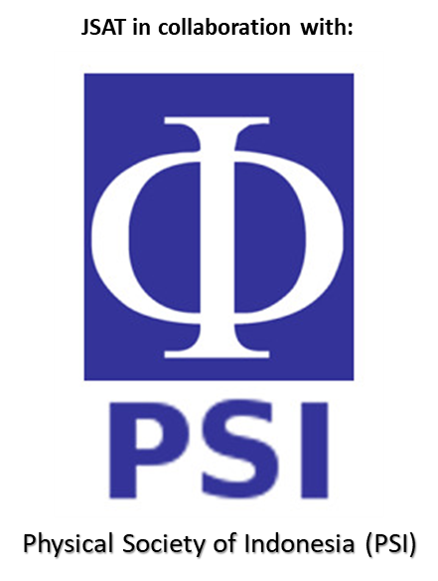Activated Cassava Leaves As Low-Cost Adsorbent to Remove Dyes From Water
Abstract
In this study, activated cassava leaves were prepared using NaCl (CLN) and KOH (CLK) as novel and low-cost materials for removing dyes from water. The prepared materials were characterized using Fourier transform infrared spectroscopy (FTIR) and scanning electron microscopy (SEM). The adsorption experiments were carried out under different conditions of initial dye concentration (50 – 600 ppm), pH solution (4 – 10), and contact time (1 – 180 min) under room temperature. The adsorption kinetics has been studied using the pseudo-first and pseudo-second-order. The equilibrium isotherms have been analyzed using the Langmuir and Freundlich models. The adsorption kinetics of methylene blue onto activated cassava leaves follows a pseudo-second-order model. According to the isotherm study, the Langmuir model shows the best fitting results with the maximum adsorption capacity of 217.39 mg/g and 416.66 mg/g for cassava leaves that were activated by NaCl and KOH, respectively.
Downloads
References
[2] G. Samchetshabam, A. Hussan, T. G. Choudhury, and S. Gita, “Impact of Textile Dyes Waste on Aquatic Environments and its Treatment Wastewater Management View project Tribal Sub Plan View project,” Environ. Ecol., vol. 35, no. September, pp. 2349–2353, 2017.
[3] F. Akarslan and H. Demiralay, “Effects of textile materials harmful to human health,” Acta Phys. Pol. A, vol. 128, no. 2, pp. 407–408, 2015.
[4] M. Z. B. Mukhlish, M. M. R. Khan, A. R. Islam, and A. N. M. S. Akanda, “Removal of reactive dye from aqueous solution using coagulation-flocculation coupled with adsorption on papaya leaf,” J. Mech. Eng. Sci., vol. 10, no. 1, pp. 1884–1894, 2016.
[5] C. Xu, G. P. Rangaiah, and X. S. Zhao, “Photocatalytic degradation of methylene blue by titanium dioxide: Experimental and modeling study,” Ind. Eng. Chem. Res., vol. 53, no. 38, pp. 14641–14649, 2014.
[6] C. Shi, F. Tao, and Y. Cui, “Evaluation of nitriloacetic acid modified cellulose film on adsorption of methylene blue,” Int. J. Biol. Macromol., vol. 114, pp. 400–407, 2018.
[7] Z. Heidarinejad, O. Rahmanian, M. Fazlzadeh, and M. Heidari, “Enhancement of methylene blue adsorption onto activated carbon prepared from Date Press Cake by low frequency ultrasound,” J. Mol. Liq., vol. 264, pp. 591–599, 2018.
[8] Y. L. Cao, Z. H. Pan, Q. X. Shi, and J. Y. Yu, “Modification of chitin with high adsorption capacity for methylene blue removal,” Int. J. Biol. Macromol., vol. 114, pp. 392–399, 2018.
[9] H. Zhang, X. Yong, J. Zhou, J. Deng, and Y. Wu, “Biomass Vanillin-Derived Polymeric Microspheres Containing Functional Aldehyde Groups: Preparation, Characterization, and Application as Adsorbent,” ACS Appl. Mater. Interfaces, vol. 8, no. 4, pp. 2753–2763, 2016.
[10] F. Boudrahem, F. Aissani-Benissad, and A. Soualah, “Adsorption of lead(II) from aqueous solution by using leaves of date trees as an adsorbent,” J. Chem. Eng. Data, vol. 56, no. 5, pp. 1804–1812, 2011.
[11] N. Nasuha, B. H. Hameed, and A. T. M. Din, “Rejected tea as a potential low-cost adsorbent for the removal of methylene blue,” J. Hazard. Mater., vol. 175, no. 1–3, pp. 126–132, 2010.
[12] Chairunnisa and Y. Lisafitri, “Preliminary studies of cassava leaves’ ability to remove dyes from water,” J. Math. Fundam. Sci., vol. 52, no. 1, pp. 66–80, 2020.
[13] H. Pereira, D. Carvalho, J. Huang, M. Zhao, and G. Liu, “Improvement of Methylene Blue removal by electrocoagulation / banana peel adsorption coupling in a batch system,” Alexandria Eng. J., vol. 54, no. 3, pp. 777–786, 2015.
[14] D. Siswanta and A. Suratman, “Shirasu Balloons and Polydopamine-Modified Shirasu Balloons for Adsorption of Methylene Blue,” Water, Air, Soil Pollut., 2016.
[15] S. P. Patel, M. Thomas, A. V Patel, and J. V Patel, “Study of KOH Impregnated Jack Fruit Leaf Based Carbon as Adsorbent for Treatment of Wastewater Contaminated with Nickel,” Int. J. Recent Trends Eng. Res., vol. 02, no. July, pp. 219–229, 2016.
[16] R. Wang, P. Wang, X. Yan, J. Lang, C. Peng, and Q. Xue, “Promising porous carbon derived from celtuce leaves with outstanding supercapacitance and CO2 capture performance,” ACS Appl. Mater. Interfaces, vol. 4, no. 11, pp. 5800–5806, 2012.
[17] Q. Li, Y. Hou, J. Wang, Y. Liu, N. Xiang, and Z. Huang, “Superiority of Raw Biomass and Potassium Hydroxide in Preparation of Ultrahigh Nitrogen Doping of Carbon for NH3-SCR Reaction,” ACS Sustain. Chem. Eng., vol. 8, no. 30, pp. 11308–11316, 2020.
[18] H. B. Z. Mohamad Zulfika, R. Baini, and N. S. Ahmad Zauzi, “Effect of pH, Dosage and Concentration on the Adsorption of Congo Red onto Untreated and Treated Aluminium Dross,” IOP Conf. Ser. Mater. Sci. Eng., vol. 205, no. 1, 2017.
[19] S. Abdelkarim, H. Mohammed, and B. Nouredine, “Sorption of Methylene Blue Dye from Aqueous Solution Using an Agricultural Waste,” Trends Green Chem., vol. 03, no. 01, 2017.
[20] A. Ebrahimian Pirbazari, E. Saberikhah, M. Badrouh, and M. S. Emami, “Alkali treated Foumanat tea waste as an efficient adsorbent for methylene blue adsorption from aqueous solution,” Water Resour. Ind., vol. 6, pp. 64–80, 2014.
[21] J. Yan, Y. Huang, Y. E. Miao, W. W. Tjiu, and T. Liu, “Polydopamine-coated electrospun poly(vinyl alcohol)/poly(acrylic acid) membranes as efficient dye adsorbent with good recyclability,” J. Hazard. Mater., vol. 283, pp. 730–739, 2015.
[22] V. Ponnusami, R. Madhuram, V. Krithika, and S. N. Srivastava, “Effects of process variables on kinetics of methylene blue sorption onto untreated guava (Psidium guajava) leaf powder: Statistical analysis,” Chem. Eng. J., vol. 140, no. 1–3, pp. 609–613, 2008.
[23] R. R. Krishni, K. Y. Foo, and B. H. Hameed, “Adsorptive removal of methylene blue using the natural adsorbent-banana leaves,” Desalin. Water Treat., vol. 52, no. 31–33, pp. 6104–6112, 2014.
Copyright (c) 2022 Journal of Science and Applicative Technology

This work is licensed under a Creative Commons Attribution-NonCommercial 4.0 International License.
All the content on Journal of Science and Applicative Technology (JSAT) may be used under the terms of the Creative Commons Attribution-NonCommercial 4.0 International License.
You are free to:
- Share - copy and redistribute the material in any medium or format
- Adapt - remix, transform, and build upon the material
Under the following terms:
- Attribution - You must give appropriate credit, provide a link to the license, and indicate if changes were made. You may do so in any reasonable manner, but not in any way that suggests the licensor endorses you or your use.
- NonCommercial - You may not use the material for commercial purposes.
- No additional restrictions - You may not apply legal terms or technological measures that legally restrict others from doing anything the license permits.





















